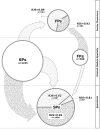Specialty selection and relative job satisfaction of family physicians and medical specialists in Austria
- PMID: 18581616
- PMCID: PMC2443622
- DOI: 10.3325/cmj.2008.3.375
Specialty selection and relative job satisfaction of family physicians and medical specialists in Austria
Abstract
Aim: To estimate the relative job satisfaction of Austrian family physicians and other specialists with respect to whether or not they obtained training in the desired specialty.
Methods: In this cross-sectional study, we re-examined the previous data on allocation of medical training posts in Austria. All board-certified physicians practicing in Vienna were surveyed with a 12-item questionnaire. We analyzed the association between respondents' desired and practiced medical specialty and their answer to the question of whether they thought they would have had greater job satisfaction in a different medical specialty. We also calculated their relative job satisfaction.
Results: Of 8127 licensed physicians, 2736 (34%) completed the questionnaire in two mailings. Of physicians who completed the questionnaire, 50.3% (43.2% of men) did not obtain the training in their desired specialty and 65.1% stated that they had originally desired a different specialty. There was a significant difference in relative job satisfaction between specialists who got their desired medical specialty (n=1005) and those who did not (n=697) (0.95 vs 0.62 of maximum 1, P<0.001). No significant difference in relative job satisfaction was found between family physicians who had originally wanted to become specialists (n=679) and specialists who had originally wanted to become family physicians (n=533; 0.89 vs 0.81; P=0.01; chi(2) test).
Conclusion: A high percentage of family physicians in Austria had originally wanted to become practitioners of a different specialty. Among physicians who did not receive training in their desired medical specialty, family physicians showed a significantly higher relative job satisfaction than specialists. Obtaining the desired medical specialty is a strong predictor of relative job satisfaction among specialists, but not among family physicians.
Figures




Similar articles
-
Allocation of training posts to applicants for postgraduate medical education in austria: survey and analysis.Acad Med. 2004 Jul;79(7):703-10. doi: 10.1097/00001888-200407000-00019. Acad Med. 2004. PMID: 15234925
-
[Recruitment of physicians in Austria for graduate medical training in psychiatry].Psychiatr Prax. 2010 Jul;37(5):248-51. doi: 10.1055/s-0029-1223534. Epub 2010 Jul 1. Psychiatr Prax. 2010. PMID: 20597039 German.
-
Job satisfaction and workplace characteristics of primary and specialty care physicians at a bimodal medical school.Acad Med. 2001 Nov;76(11):1148-52. doi: 10.1097/00001888-200111000-00020. Acad Med. 2001. PMID: 11704519
-
Job satisfaction among certified and non-certified general practitioners.Isr Med Assoc J. 2000 Nov;2(11):823-7. Isr Med Assoc J. 2000. PMID: 11344751
-
[What do the new specialty training regulations mean for physicians in general surgery and visceral surgery? : A contribution from a Bavarian perspective].Chirurgie (Heidelb). 2023 Nov;94(11):901-904. doi: 10.1007/s00104-023-01965-z. Epub 2023 Sep 27. Chirurgie (Heidelb). 2023. PMID: 37755467 Review. German.
References
-
- Boerma W, Dubois C. Mapping primary care across Europe. In: Saltman RB, Rico A, Boerma W, editors. Primary care in the driver’s seat? Organizational reform in European primary care. Berkshire: Open University Press McGraw-Hill; 2006. p. 22-49.
-
- Austrian Health Institute. Quality of health care in Austria [in German]. Vienna: ÖBIG; 2000.
-
- Starfield B, Shi L, Grover A, Macinko J. The effects of specialist supply on populations' health: assessing the evidence. Health Aff (Millwood) 2005;(Suppl Web Exclusives):W5-97–W5-107. - PubMed
Publication types
MeSH terms
LinkOut - more resources
Full Text Sources

